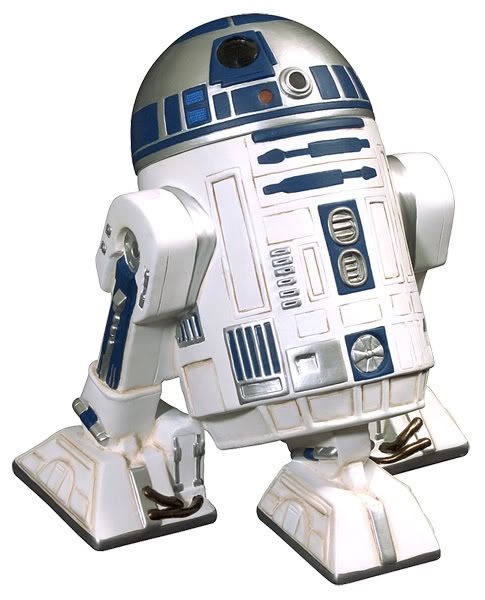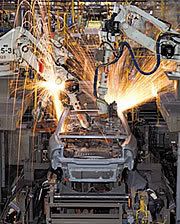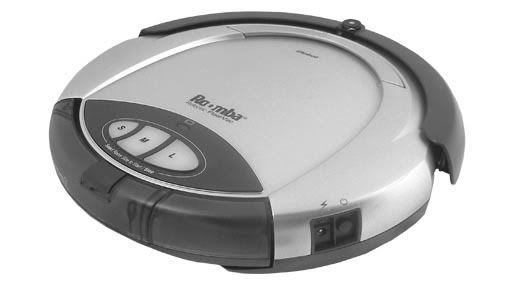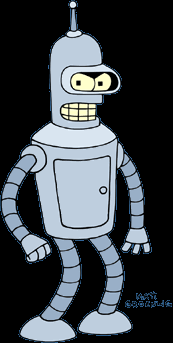Friday, August 3, 2007
Virtual instrumentation
Virtual instrumentation is use of software and modular measurement hardware to customise measurement systems. There are virtual instrumentation software packages available. The most used are National Instrument’s Labview, National Instrument’s Measurement Studio, and Agilent VEE. The most common of these is National Instrument’s Labview.
Friday, July 20, 2007
Remote operation of a robot.
Sometimes, it is too difficult or too dangerous to be in direct control of a robot. In such cases, we can set the robot up for remote control. Many of you are already familiar with this concept – Remote controlled toy cars work on this concept, but in short range. Sometimes we need to operate a robot from perhaps thousands of kilometres away.
Robots controlled this way are connected to the information superhighway – the internet. It is possible to control the robot using only a keyboard and mouse. The instructions you send it are translated by a machine to tell the robot what to do. It is more effective to have one or more webcam trained on the robot or robot arm to see what is happening.
Friday, July 6, 2007
Robotics - offsite monitoring
Off site monitoring
There are two ways to check a site’s robot/s remotely. The first, and easiest way is by webcam. Setting up a webcam and a webpage to match requires a little knowledge of HTML, PHP, or some other internet scripting technique. A live webcam feed allows you to see the robot’s progress and any potential external errors.
The second, and most common, way to check a robot is to use sensors. There are all sorts of sensors for all sort of applications – distance (or length), weight, arm angle, motion, etc. depending on how the robot is configured, and what needs to be checked. A lot of sensors can be wired up to a main computer.
A sensor should only trigger an alarm if something is wrong, and it should alert the problem to the relevant person. The sensor should also give an indication of its status within set bounds, so any potential problem can be seen early and fixed before any potential problem becomes a disaster.
Friday, June 22, 2007
Remote operation and control over long distance.
In the instance you may want to control a device over hundreds of kilometres, wireless control and control panels are not possible. Instead, you would have a remote linkup to the device, and a computer control. Over the coming weeks, I will take you some techniques for long distance remote operation and monitoring.
Friday, June 8, 2007
Remote operation of short distances.
With our without wires, it is possible to control a robot remotely. There are many ways to do this. The simplest would be the use of a control panel. Each button on the control is a specific item to do with the machine, and there would generally be a joystick to control movement.
The other way is to use a scaled down replica of the robot. In cases where you need precise control, and in special effects where you are interacting with a live audience, yo would generally use a combination to create more realistic effects., but how does this work?
In the scaled version, there are motion sensors that detect motion in all three directions, as well as tilt. These are linked to a processor that may be external to the replica which tells the robot what to do. Such a process is being used in the ‘Walking with Dinosaurs’ production running in Sci-tech in Perth, Western Australia.
Friday, May 25, 2007
GPS navigation
As time goes on, more and more people are relying on GPS systems installed into their car to guide them on a journey. These are usually to places they have never been before. No doubt they’re great systems, but there are pitfalls when using one, and pitfalls when buying one.
What is GPS?
GPS stands for Global Position System. It was designed by the US military for accuracy in long range attacks, surveillance, and R&D. There are currently about 2 dozen GPS satellites in orbit. They can calculate your position from your signal, its position and three or more satellites. This is a technique called trilateration (for more info on trilateration, click here. There are two levels of accuracy – the military one, which is about 3m, and the civilian one, which is about 15m.
Who are the suppliers of in-car navigation systems?
There are many suppliers – Garmin, TomTom, NavMan, Mitec to name a few. It is important to look around and see what you are willing to pay, and what is available. Don’t buy something because someone else says it’s good.
Why are they good?
Navigation systems tend to replace maps. Maps that get used a lot tend to get dog-eared and pages can go missing. You can also set the system to guide you to your destination, and it will give clear directions where to turn.
Why are they bad?
First things first, people are beginning to rely too much. There are cases where people have gone off the road following the instructions of the GPS, regardless of what the roads signs said – especially more so in construction zones, which may change condition daily. Also, the map in the system may become old – new roads may not have been added in. It’s possible to update the map – most companies use cards or a CD which can be replaced, but is far more expensive.
Friday, May 11, 2007
Robotics today and the future – are they good for us?
There is no doubt that all of us want a robot, whether it’s for company, for protection or for help. Robots can be good or bad, depending on what we want from them, and what limitations we may decide to impose on them, but are robots really good for us? Today we discuss one of the cons of the robots of the future.
On thing which may not surprise you is that we are becoming fatter each year. The cause of this is said to be fast food and junk food, but I think this may not be the case. You only have to look at the Amish to see the fallacy in blaming fatty foods – they are fit and healthy. Why?
As more cars get on the road, we get lazier. We refuse to get up and walk somewhere if we can drive there. If it’s 400km away, walking may take you a long time, so driving is OK. If it’s down the street, or two block away, walk. Most of us will drive even if it’s only 1km away. We refuse to let our kids out because it’s dangerous. We lack exercise.
I fear that the robots of the future will take away our need to exercise. We may even ask them to exercise for us – not good! The reason why we have developed so many tools is because humans are inherently lazy – if there is an easier or faster way to do the same thing, we will try it or invent it. Robots may be just another symptom of this, and that we will all eventually become fat.
Sunday, April 29, 2007
DARPA grand challenge - what can we learn from this?
Autonomous vehicles are hard to design. There is always the risk of component failure, and a greater risk of not foreseeing flaws that could be potentially very nasty. Given the limited timeframe in which to develop these vehicles, there have been some very good innovations.
Autonomous vehicles are a form of robotics in which the car becomes the robot. I think many of us (including myself) would like to own an autonomous vehicle some day
Wednesday, April 25, 2007
DARPA Grand challenge - an exercise in robotics
What is it?
The DARPA grand challenge is a US based challenge sponsored by the Department of Defense under the ‘Defense Advanced Research Projects Agency’ arm. DARPA is unique in that it gives technological option to the Department of Defense. It accelerates development of technological advances to make what might be possible in the future possible.
The grand challenge is a result of the goal by the military to develop unmanned vehicles for use in warfare. In order to accelerate development in the field, DARPA created a challenge open to teams around the world to develop autonomous vehicles to drive around a preset path. The vehicles had to have no human intervention.
Sadly, no vehicle completed the race, but it did highlight some of the dangers and pitfalls when designing an autonomous vehicle. Encouraged by the result that they did move autonomously for some distance, DARPA announced a second grand challenge to be held in the desert in 2005. The goal was to drive to path in less than 5 hours. 3 vehicles managed to successfully do this, and a fourth finished the course after being parked on a hilltop overnight due to lack of battery power and low sunlight. The rest had various problems with components.
In 2006, DARPA announced another grand challenge. Dubbed the urban challenge, he vehicles must now successfully navigate traffic, and follow local traffic laws (including traffic lights). It will be held late in 2007
Friday, April 13, 2007
Mechatronics and you - electronic stability in cars
Electronic stability in cars – how it works.
Electronic stability control (ESC) (marketed under different marketing names by different companies) is a program in some newer cars that tries to prevent oversteer and understeer in cars. ESC cannot prevent crashes – merely reduce the severity of impact.
Electronic stability works by comparing the drivers intended direction to the actual response of the vehicle by sensing lateral acceleration, individual wheel speeds and rotation and responds accordingly.
ESC is an example of mechatronics at work – it is a moving system using electronics to control and get a desired response.
Sunday, April 8, 2007
Robotics and Mechatronics part 2
The common dream of most Mechatronic engineer is to build robots. In the meantime, Mechatronic engineering graduates design and supervise construction of systems automation. Industrial robots are programmed and maintained by Mechatronic engineers.
Robotics and mechatronics part 2
Robotics and their associated programming requires knowledge of electrical systems and mechanical movement. Robots are constrained in their movement. This can be 1-axis, 2-axis, 3-axis, or multiple axis robots.
Multiple axis robots can be hard to program. It is easier to program a 2 axis robot than a 3-axis one, as you have limitations on its motion based on its wires and its motors.
As I mentioned in a previous article, robotics have invaded many industries to increase productivity. They are far more precise, accurate, and less prone to boredom. Robots can be programmed to do anything within their capabilities.
Wednesday, April 4, 2007
what do companies usually advertise that relate to mechatronics engineering?
You may be looking for the words ‘mechatronics engineers’ specifically, and you wont find a lot of companies advertising this way. Mechatronics is a new engineering field, so you won’t find a lot of senior mechatronics engineers. In order to not restrict their search, they don’t advertise for mechatronics engineers specifically. Some of the more common positions which a mechatronics engineers can apply for are:
• Asset Engineer
• Automation engineer
• Data Logging engineer
• Electrical/Electronic engineer
• Electro mechanical engineer
• Instrumentation engineer
• Maintenance engineer
• Mechanical engineer
• Plant engineer
• Process engineer
• Process monitoring and plant systems engineer
• Project engineer
• Software engineer
• Systems engineer
Wednesday, March 21, 2007
mechatronics and robotics part 1
What is mechatronics?
This is a commonly asked question in industry, so it is best if it is answered so people know what it is, exactly.
Mechatronics is a relatively new field of engineering. It was born out of industry pressure to create an engineer who could adapt. Traditional disciplines have grown so far apart, it has become hard for them to work together.
Mechatronics is a unique blend of computer science, Mechanical engineering, and Electrical engineering. It gives the mechatronics engineer an understanding in those field in order to tie them together. They are able to combine the necessary elements together to provide automated systems.
Why should you employ a mechatronics engineer?
COST!
Most traditional engineers regard the mechatronics engineer as 1/3 mechanical, 1/3 electrical and 1/3 computer science with not enough knowledge in any to be any good. In fact, research has shown that an engineer picks up most of his or her knowledge while working, and not studying.
A mechatronics engineer has good fundamental grounding in all three fields. He or she is a specialist in automation. A good mechatronics engineer will be able to take control of a project that involves automation, and ensure that everything will work. He or she will have enough background knowledge to be able to pick out any problem before it becomes a major issue (problem resolution is another thing though…). Any major delays can be avoided this way, saving you potentially millions of dollars.
Wednesday, March 7, 2007
industrial robotics - a very commonly discussed topic
There is extensive debate about what a robot consists of. Some people insist it has to be bipedal, interact with humans and be able to think on its own. There are already robots like this, albeit experimental. The most well known one of this form is ASIMO. It is a research robot by Honda - more about this in a later article.
Robots, and more specifically robotics, have become very useful in industry. In these instances, they perform tasks too dangerous or too repetitive for humans to do. You will see them in manufacturing, parts fabrication, and so on. There is an ISO standard for industrial robots, which ensures a minimum standard to classify an industrial robot as a robot. The ISO definition is:
an automatically controlled, reprogrammable, multipurpose manipulator programmable in three or more axes
What does this mean for you?
This means you have probably worked with a robot if you have programmed a piece of equipment to do a specific task for you. If you have worked alongside a piece of equipment that fast and precise, you have worked alongside a robot.
Robots are very common in industries that carry a fair amount of danger, or a lot of repetition in the work. For example, robotic arms with welders are used in the automotive industry to weld car parts together. As you can imagine, the precision and repetition of the work would ensure a greater chance of a defective vehicle, or that there is an accident in the workplace. Robots have not completely taken over every possible job imaginable. You still need humans to weld the intricate parts together, and to ensure that everything is ‘correct’ (i.e. to spec). A robot would not be able to see the fine details.
Wednesday, February 28, 2007
how sae are today's robots? A discussion question on robotics
How safe are robots?
This is a common question discussed due to the popularity of robots in television and film. Most of today’s robots are relatively safe – within certain boundaries, of course. Exercising caution, you are not likely to be killed by robots in today’s society. This is of course a relief for those fearing for your lives. You are also not like to come to a robot face to face, unless you work in an industry near automatic welders, and the like.
In the future however, there will be more human looking robots. Boundaries will be blurred, and you will be thinking ‘will we be hurt? Will they turn against us?’. Rest assured – robots in the future will have to abide by the three laws of robotics. These are:
- A robot may not injure a human being or, through inaction, allow a human being to come to harm.
- A robot must obey orders given it by human beings except where such orders would conflict with the First Law.
- A robot must protect its own existence as long as such protection does not conflict with the First or Second Law.
There are loopholes in these laws – the first can be broken unknowingly. In order to combat this, some people have suggested to make to robots altruistic and allow them to us their own judgement. This sidesteps potential unforseen circumstances.
Wednesday, February 21, 2007
Robots of the future - a question often discussed about robots
A discussion about robots in a general setting between friends, family, workmates, or someone off the street, will give you a wide variety of answers as to what they want a robot to fully perform – all the tasks they want a robot to be able to do. However, there is a variety of common tasks we would like the robot of the future to perform. These include:
· As Friends and/or companions – a way of helping elderly or lonely people feel loved. Robots like these would be welcome in nursing homes and in refuge shelters. We would also like to see them in the household.
· As helpers – with all the common household chores, it would be handy to have a robot that would not tire of the work. This is probably the most common ability most people want their robots to have. I’m sure all the ladies (and some men) would agree that a helper doing the household chores would be helpful. I think children around the world would rejoice – no more household chores (although I don’t know if that’s a good or bad thing…)
· As police officers - no pay strikes, no disputes. I’m sure most people would want robot officers, as it would just be easy to increase police numbers. There are, however, numerous coffee table discussions involving what capabilities the police officer robot should have. The include, but are not limited to:
o How humane do you want the police robot to be?
o Shoot to kill on sight?
o What type/s of arms should it be equipped with?
· As nurturers – they would play with your children and feed them while you are out at work. This would increase your productivity as you no longer about whether your children are being fed properly
There are many more things people want in their robots, but they are too numerous to list. Instead, I hope the above list of the three most common ideas of the what the ideal future robot should do helps stimulate discussion about robots with the people you know.
Wednesday, February 14, 2007
discussion on interpreting robot sensor data - DAQ's PART 2
How much is a DAQ?
DAQ’s vary in price depending on manufacturer and specs. For example, the DAQ ADC11/12 by Pico was around $500aud from memory. This had 11 input channels, and was used in a UWA Mechatronic project testing forces on a walking frame (an ongoing student project). The DAQ’s from National Instrument were $800AUD minimum,
What connections are used with a DAQ?
There are a variety of connections, including USB, serial, PCMCIA, among others. If you are buying one with a new computer or laptop, I suggest USB for connectivity and portability.
NOTE: DO not go out an buy a DAQ, just to have a DAQ. If you want to know how to connect the DAQ to your robot/electronic device/ other electrical device then this will be posted next post.
How do I connect my robot/other electronic device to a DAQ?
This is not easy. It requires basic knowledge in circuitry and proficiency in soldering. As a result, I strongly recommend that if you have not got these skills or are under the age of 13, ask your mum, or preferably you dad, to do this for you.
First, look at the electronic circuit, and locate which are the output ports, and which ones are the inputs. (eg, the light sensor is the input and the connection from the light sensor is the output) Also locate which side the higher voltage is. Note this down on a printed diagram or on a piece of paper.
Second, get wires, and twist them into pairs. Solder one side of each pair at each of the outputs. This allows us to ‘read’ the information coming in.
Third, wire the twisted pairs into a parallel port/serial port/other port connector. For beginners, use a parallel port, and get a DAQ with a parallel port input. You can get these from RS components in
Fourth, plug your connector into your DAQ, and the DAQ into your computer.
Run the DAQ software.
How do I interpret the data coming from the DAQ software?
There are a number of ways to do this. Firstly, you need to know which sets of signals are coming from which sensor.
The numbers on the graphs, as your robot/ other device works is the sensor outputs. This means you can see when it fails, has problems, etc. you can then set new limits to stop your robot/other device from failing or running into problems.
There is another way to do this that is more visually appealing. There are programs such as Matlab, and national Instruments labview which allow you to write software that interfaces with the DAQ itself. There are a number of software that does this for you. I recommend Labview, but only because I have used it. There is a variety of different software that does this – go search for it.
well... that's all I can say about DAQ's. see you next week for more discussion about robotics.
Wednesday, February 7, 2007
Robotics discussion questions – how do I measure what my robot is ‘sensing’?
Where do I get a Data Acquisition device (DAQ)?
DAQ’s are specialised pieces of equipment. Chances are you will not find one in your local hardware store. They can be found in a specialist elcectrical/electronics equipment supply store, such as RS components in
What brands can I expect to find?
Because you will generally only use these to gather test and field data, they are not manufactured by everybody. Some of the more common brands are National Instruments, and Pico.
What is 'the best' DAQ?
This is a question commonly asked by people, and is not a question linked directly to robotics.
There is no ‘best’ DAQ, only the best one for your need. If you don’t need to buy a DAQ with 0.5% accuracy, don’t.
that's all I have time for this week. More on DAQ's later.
Wednesday, January 31, 2007
Famous robots in film and TV
One of the most discussed questions in relation to robots are in fact the film robots, so here are a few
Famous robots in Tv and film
Terminator.

Appeared in all three Terminator films. Full name is T-100. In each film, the terminator sent back is a different one. There are three types of terminator seen in the films: T-100 (played by Arnold Schwarzenegger), T-1000, and T-X (AKA Terminatrix).
Bender (Futurama)
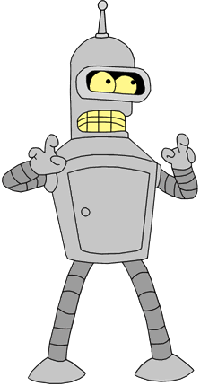 Bender is a loud mouthed, obnoxious beer drinking robot in the animated series Futurama. According to the episode “mars university”, he attended college, majoring in bending, and minoring in robo-american studies. He is also revealed to be 30% iron in the episode “The 30% Iron Chef”. Bender’s appearance is what we imagine what a robot would be like.
Bender is a loud mouthed, obnoxious beer drinking robot in the animated series Futurama. According to the episode “mars university”, he attended college, majoring in bending, and minoring in robo-american studies. He is also revealed to be 30% iron in the episode “The 30% Iron Chef”. Bender’s appearance is what we imagine what a robot would be like.
R2D2
Perhaps the most famous robot in film. R2D2 is a special type of robot known as a droid. He serves as a helpful aid to some of the characters in the star-wars movies.
Tuesday, January 23, 2007
what are some common toy robots?
In order to answer this discussion question on toy robotics, here are two well know examples of yesteryear.
Who can forget the fluffball of fun? When first released in 1998, it revolutionised toys with its ability to interact with its ‘owners’ with speech and automated movement.
Aibo is the robotic pet dog created by Sony Corp. While most people see Aibo as an interactive toy, it is in essence a robot, as it is controlled by a computer chip. Aibo is also used for research into artificial intelligence as it is cheaper than conventional research robots.
Monday, January 15, 2007
robotics discussion questions - what is robotics?
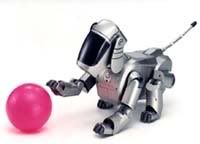
Robotics, put simply, is the use of electrical components to move mechanical components. The key components of robots are their ability to perform repetitive tasks in a precise manner
Where are robots used? Another one of those robotics discussion questions.
There are many robots in industry today doing jobs too repetitive or too dangerous for a human to do. These include continuous welding for steel pipes, welding car components in an assembly line, bomb disposal, and clearing of toxic waste to name a few.
Many people want a robot that is bipedal, can walk and talk, as well as look human. We are rapidly advancing on this with the bipedal robots from Honda, Sony, and other Japanese companies with R&D in electronics. We aren’t quite at that stage yet, but there have been household robots designed to make life easier. these include the roomba and Mistibishi's domestic helper known as wakamaru.
We are rapidly getting to the point where we could build the 'dream robot' such as the one below.
no. not that one....

this one.















